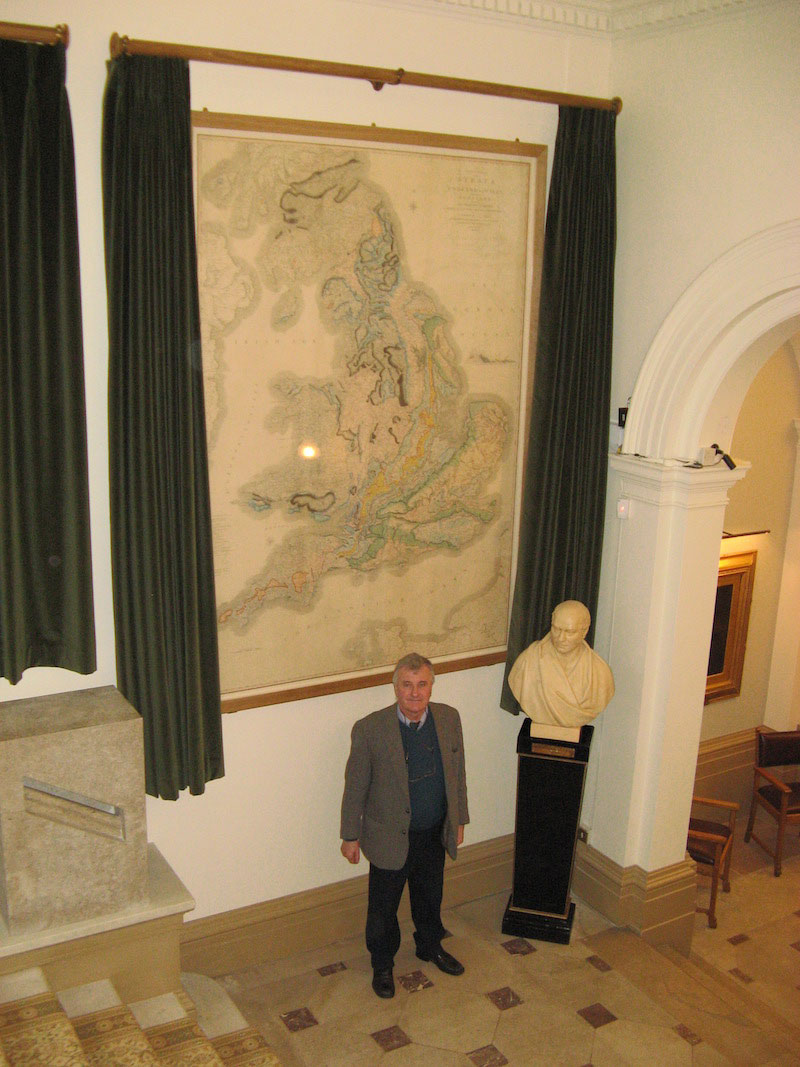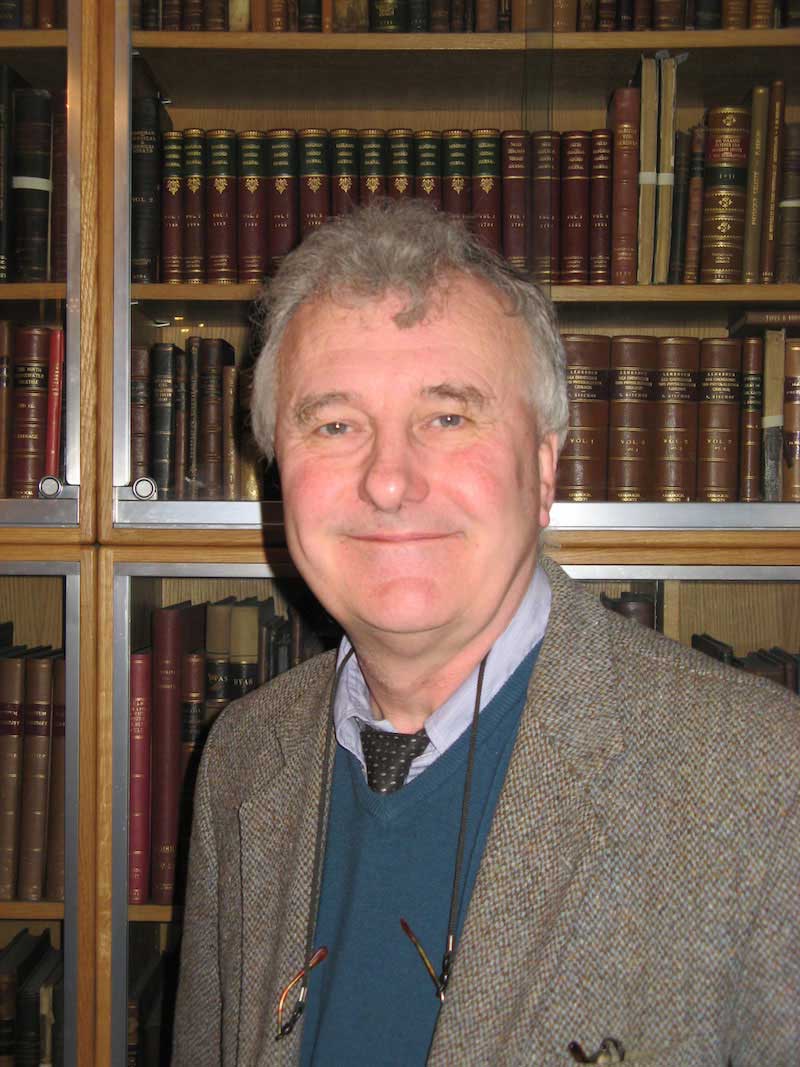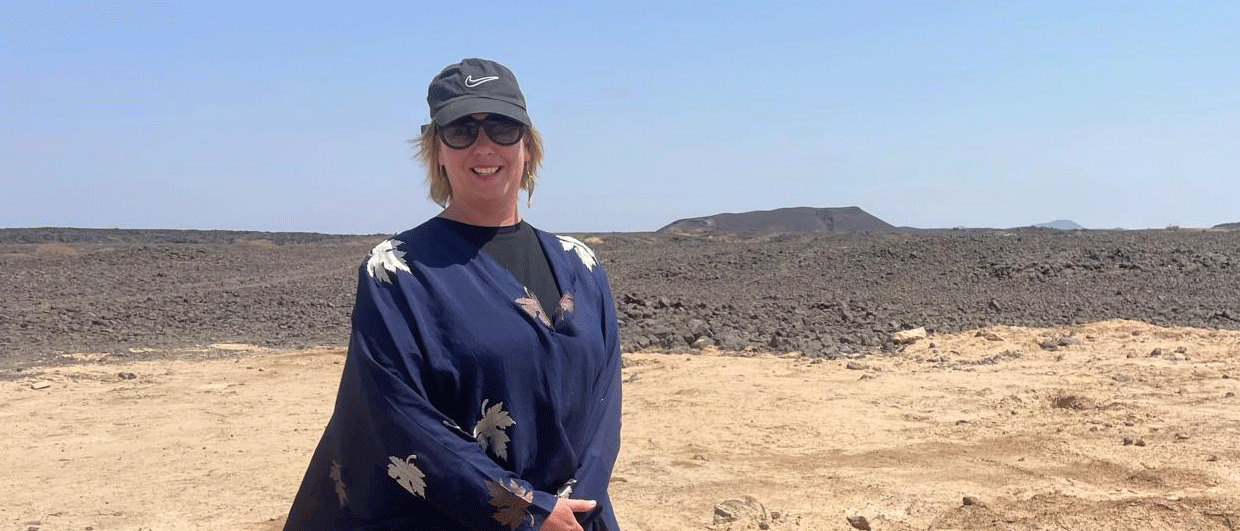When the Geological Society was looking for a President to be its public face during the year which sees the 200th anniversary of the founding of the association, Dr. Richard Fortey was an obvious choice. Although well known and respected in his chosen field as a palaeontologist and trilobite expert, he is better know to the general public as the man who makes geology exciting.
Successfully explaining geology
 Dr Fortey stands in the recently refurbished lobby of the Geological Society, beside a bust of William Smith, whose 1815 Geological Map of Britain hangs on the wall behind him. Photo: Jane Whaley“In 1993 I was asked to write a book about the landscape ‘in my own voice’, to explain to the layman why Britain is shaped as it is,” Richard explains. “I think geologists always look at the land in a different way. It’s a cultural thing: I don’t think people realise that the way pictures are painted or books are written is totally related to geology and I wanted to help them to understand this. Wuthering Heights is not Wuthering Heights without the Millstone Grit! I’m quite well read – for an earth scientist – so I was able to build in little literary excursions along the way.
Dr Fortey stands in the recently refurbished lobby of the Geological Society, beside a bust of William Smith, whose 1815 Geological Map of Britain hangs on the wall behind him. Photo: Jane Whaley“In 1993 I was asked to write a book about the landscape ‘in my own voice’, to explain to the layman why Britain is shaped as it is,” Richard explains. “I think geologists always look at the land in a different way. It’s a cultural thing: I don’t think people realise that the way pictures are painted or books are written is totally related to geology and I wanted to help them to understand this. Wuthering Heights is not Wuthering Heights without the Millstone Grit! I’m quite well read – for an earth scientist – so I was able to build in little literary excursions along the way.
“The book proved popular, so I was commissioned by Harper Collins to write ‘Life: an Unauthorised Biography’ which was published in 1996. This was a history of life from first cell to man, quite a large undertaking, written in the same accessible way. I introduce elements of my own life into it, including explaining how I became a palaeontologist when I went as a research assistant to Spitsbergen, where we found huge numbers of fossil trilobites. I use this story as a way of introducing geological time, which is always a problem. One gets so tired of books which talk about the ‘clock’ of geological time. I wanted to write so it read like a novel.”
Richard was obviously successful in this aim, as the book sold over 200,000 copies and has been translated into several languages.
Trilobite!
Richard’s next book went to the heart of his geological passion. Called simply ‘Trilobite!’ it is a view of the world and evolution through the eyes and times of this extinct creature. “People have always been fascinated by dinosaurs – I wanted to do the same for trilobites. Not many plastic models in cereal packets yet, though!” Since all 15,000 hardback copies sold, Richard obviously went some way towards his aim.
“As a boy, I was interested in anything to do with natural history,” Richard explains. “I used to go fossil hunting on holiday in South Wales, but I was also interested in birds, flowers, even fungi. My school in North London offered Geology A level, and I was hooked. I studied Geology at Cambridge and was inspired by the palaeontologist Henry Whittington. I then went on that research trip to Spitsbergen, discovered one of the richest trilobite fossil locations in the world, and my career was marked out! I am fascinated by trilobites because they are remarkably complex animals considering their antiquity. They can be used to reconstruct ancient geographies and oceans, so they are of general geological significance, but really, they are just very appealing creatures.”
“After my Ph.D I was offered a research post at the Natural History Museum in London. Apart from a couple of sabbaticals, I was there for the next 35 years, until I retired last year. In many ways I regard working for the Museum as the plum job in research. My task was to devise projects, obtain funding, undertake the research and publish. Sorting out my papers when I retired, I realised I had published over 200 papers, some of them quite substantial monographs.”
Promulgating geology
Richard is very happy to be President of the Geological Society at this important time. “I was probably asked to stand because I am known to both industry and academics, as well as the media, although as a palaeontologist I’m a bit of a rarity – I don’t know the last time one was President.”
“I am keen to promulgate geology as much as possible and I feel strongly that we need to get out there more, instead of just talking among ourselves. Let’s face it, a lot of the major issues facing us are at heart geological,” he explains. “Climate change, alternative fuel sources, CO2 sequestration, mitigating sea level rise: all these concern geologists. I see our role becoming more and more important. I would like the government, media and public in general to be much more aware of us, and to come to the Geological Society for impartial, informed advice as a matter of course.”
“I think the public face of the Geological Society has improved dramatically over recent years. This year in particular we have organised events like the Shell public lecture series and our large Bicentennial Conference, a forward looking forum to discuss where the science is going. As a bicentennial project we have put all our papers and publications on line, which will be a route to good advice and information.”
Trilobites and the oil industry
 Dr. Richard Fortey is one of the few palaeontologists to have been elected President of the Geological Society. Photo: Jane WhaleyWould Richard like to see more interaction between the oil industry and the Geological Society? “I’d like to see more oil people care about chartership. The Petroleum Group in the Society is quite strong, but it’s also pretty independent. The hydrocarbon industry is the major sponsor for our bicentennial celebrations and I’d like to think we give back in return, particularly in our publications on topics like North Sea geology.”
Dr. Richard Fortey is one of the few palaeontologists to have been elected President of the Geological Society. Photo: Jane WhaleyWould Richard like to see more interaction between the oil industry and the Geological Society? “I’d like to see more oil people care about chartership. The Petroleum Group in the Society is quite strong, but it’s also pretty independent. The hydrocarbon industry is the major sponsor for our bicentennial celebrations and I’d like to think we give back in return, particularly in our publications on topics like North Sea geology.”
Richard admits that he has limited experience of the industry himself, although a few years ago he was asked by Shell to use trilobites for age determination of the Lower Palaeozoic in Oman. Interestingly, when he discovered both shallow water trilobites and trace fossils, rarely found together, this oil industry work lead to a research project, partially funded by the company.
“As this shows, there is more interaction between the hydrocarbon industry and academic research than is often thought. I have been strongly involved in reconstructing Ordovician palaeocontinents which, of course, has huge implications to the generation and emplacement of hydrocarbons. We need to keep a supply of academics such as myself in the universities and museums, doing research and looking after collections, otherwise the industry will have nowhere to turn for this expertise. When I started the job was ‘to become an authority’ and publish. Now, however, the measure of success is getting a grant, not writing a monograph. This isn’t good for the intellectual health of the country.”
Science Communication Awards
Richard appears to have been very successful in getting the wonder and excitement of geology across to a wider public through his books, and this has been recognised through several awards and prizes. In the 2002 he spent a sabbatical year as the Collier Chair of Public Understanding of Science and Technology at Bristol University, which gave him the opportunity to research and write ‘Earth: An Intimate History’, the other books all having been written in his spare time.
The Geological Society awarded Richard the Lyell Medal in 1996, and he received the senior medal of the Zoological Society of London in 2001 and the Lewis Thomas Prize of Rockefeller University in 2003, this last in recognition of his popular writing. He was elected a Fellow of the Royal Society in 1997.
Richard’s most recent award was the 2006 Michael Faraday Prize, awarded annually by the Royal Society for excellence in communicating scientific ideas in lay terms. Previous winners include such eminent scientists as Robert Winston, Steve Jones and Susan Greenfield.
“This resulted in the scariest public appearance I have ever made,” laughs Richard. “Accepting the prize means you agree to give a presentation to the Royal Society and, having been given a prize for helping public understanding of science, this has to be entertaining. The most daunting aspect was the audience, which ranged from old school friends and colleagues to eminent scientists and public figures like David Attenborough, himself the previous year’s winner!”
The Romance of Stones
Despite retiring, Richard Fortey does not intend to stop working. “I want to keep up with research on trilobites, but I have also agreed to write at least two more books.”
“I’d like to return to the atmosphere of the 19th century, when science was seen as romantic and people wrote books with titles like ‘The Romance of Stones’, he explains. My next book is a ‘behind the scenes’ look at the Natural History Museum, after which I may hunt out some of the organisms which have survived from deep periods of geological time.
“Although receiving these prizes and awards is very satisfying, by far the best reward for my work is in the letters I receive,” Richard says. “One person wrote to me and said ‘Your book has transformed the way I look at the world’. That’s better than any money!”





